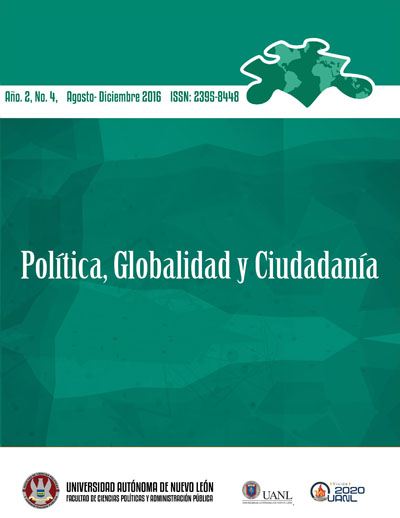Laboratorio del Procomún y Teoría del Actor Red: Propuesta de Aplicación al Proceso de Reforma a la Ley de Aguas en Méxic
Palabras clave:
Laboratorio del Procomú, Teoría del Actor Red, Ley de Agua, MéxicoResumen
Este texto tiene la intención de incentivar el uso del Laboratorio del Procomún y de la Teoría del Actor Red por la sociedad civil mexicana, de tal forma que se eficiente la participación de la ciudadanía en torno a un problema eminentemente social y con tintes de seguridad alimentaria y nacional: la Reforma a la Ley de Aguas de México.
Descargas
Citas
Beissinger, M. R. (2007). Structure and example in modular political phenomena: The diffusion of Bulldozer/Rose/Orange/Tulip Revolutions. Perspectives on Politics, 5(2), 259-276. doi: http://dx.doi.org/10.1017/S1537592707070776
Bunce, V., Wolchik, S. (2009). Getting real about “real causes”. Journal of Democracy, 20(1), 69-73. doi: 10.1353/jod.0.0063
Collier, D. y Levitsky, S. (1998). Democracia con adjetivos: innovaciones conceptuales en estudios comparativos. Agora, (8), 99-122. Recuperado de: https://goo.gl/2hCfQv
Dahl, R. (1996). Political Oppositions in Western Democracies. New Haven, London: Yale University.
Dimitrov, M. K. (2009). Popular Autocrats. Journal of Democracy, 20(1), 78-81. doi: 10.1353/jod.0.0057
Fairbanks, C. H. (2007). Revolution Reconsidered. Journal of Democracy, 18(1), 42-57. doi: 10.1353/jod.2007.0007
Hale, H, E. (2006). Democracy or autocracy on the march? The colored revolutions as normal dynamics of patronal presidentialism. Communist and Post-Communist Studies, 3(39), 305-329. doi: doi:10.1016/j.postcomstud.2006.06.006
Huntington, S. (1994). La tercera ola. Buenos Aires: Paidós.
Ibarra, P., Martí i Puig, S. y Gomá, R. (2002). Creadores de democracia radical. Movimientos sociales y redes de políticas públicas. Barcelona: Icaria Editoral.
Kalandadze, K., Orenstein, M. A. (2009). Electoral protests and democratization beyond the color revolutions. Comparative Political Studies, 42(11), 1403-1425. doi: 10.1177/0010414009332131
Linz, J. y Stepan, A. (1996). Problems of Democratic Transition and Consolidation. Baltimore: Johns Hopkins University Press.
Marat, E. (2006). The Tulip Revolution: Kyrgyzstan one year after. Washington DC: The Jamestown Foundation. Recuperado de: http://goo.gl/gjyqoL
McFaul, M. (2005). Transitions from postcommunism. Journal of Democracy, 16(3), 5-19. Disponible en: http://goo.gl/ASTfFp
O´Donnell, G. y Schmitter, P. (1986). Transitions from the Authoritarian Rule: Tentative Conclusions about Uncertain Democracies. Baltimore: The John Hopkins University Press.
Polese, A. y Ó Beachaín, D. (2011). The color revolution, virus and authoritarian antidotes: Political protest and regime counterattacks in post-communist spaces. Demokratizatsiya, 19(2), 111-132. http://goo.gl/XLBH4k
Salomón, M. (2002). La teoría de las relaciones internacionales en los albores del siglo XXI: Diálogo, disidencia, aproximaciones. Barcelona: Revista CIDOB d’Afers Internacionals, (56), 7-52. Recuperado de: http://goo.gl/xRPl6p
Schumpeter, J. (1983). Capitalismo, socialismo y democracia. Barcelona: Orbis.
Sengupta, A. (2009). Heartlands of Eurasia.The geopolitics of political space. Plymouth: Lexington Books.
Silitski, V. (2010). Survival of the fittest: domestic an international dimensions of the authoritarian reaction in the former Soviet Union following the colored revolutions. Communist and Post-Communist Studies, 43(4), 339-350. doi:10.1016/j.postcomstud.2010.10.007
Skocpol, T. (1994). Social Revolutions in the Modern World. New York: Cambridge University Press.
Skocpol, T. (1979). States and Social Revolutions: A Comparative Analysis of France, Russia and China. Cambridge: Cambridge University Press.
Tilly, C. (1978). From Mobilization to Revolution. New York: Mcgraw-Hill College.
Tucker, J. A. (2007). Enough! Electoral fraud, collective action problems, and post-communist colored revolutions. Perspectives on Politics, 5(3), 535-551. doi: http://dx.doi.org/10.1017/S1537592707071538
Tudoroiu, T. (2007). Rose, Orange and Tulip: the failed post—soviet revolutions. Communist and Post-Communist Studies, 40, 315-342. doi:10.1016/j.postcomstud.2007.06.005
Way, L. (2008). The real causes of the color revolutions. Journal of Democracy, 19(3), 259-276. Disponible en: http://goo.gl/UtvVoF
Descargas
Publicado
Cómo citar
Número
Sección
Licencia
Derechos de autor 2017 Revista Política, Globalidad y Ciudadanía

Esta obra está bajo una licencia internacional Creative Commons Atribución-NoComercial-SinDerivadas 4.0.

Esta obra está bajo una Licencia Creative Commons Atribución-NoComercial-SinDerivadas 4.0 Internacional.





